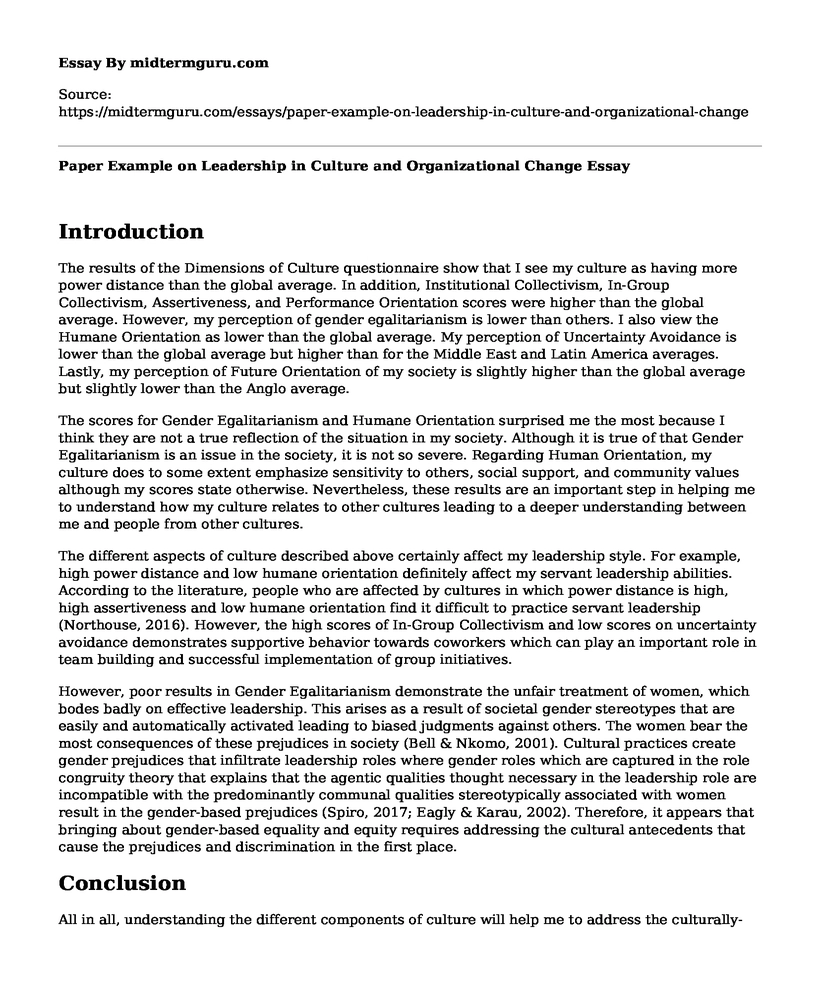Introduction
The results of the Dimensions of Culture questionnaire show that I see my culture as having more power distance than the global average. In addition, Institutional Collectivism, In-Group Collectivism, Assertiveness, and Performance Orientation scores were higher than the global average. However, my perception of gender egalitarianism is lower than others. I also view the Humane Orientation as lower than the global average. My perception of Uncertainty Avoidance is lower than the global average but higher than for the Middle East and Latin America averages. Lastly, my perception of Future Orientation of my society is slightly higher than the global average but slightly lower than the Anglo average.
The scores for Gender Egalitarianism and Humane Orientation surprised me the most because I think they are not a true reflection of the situation in my society. Although it is true of that Gender Egalitarianism is an issue in the society, it is not so severe. Regarding Human Orientation, my culture does to some extent emphasize sensitivity to others, social support, and community values although my scores state otherwise. Nevertheless, these results are an important step in helping me to understand how my culture relates to other cultures leading to a deeper understanding between me and people from other cultures.
The different aspects of culture described above certainly affect my leadership style. For example, high power distance and low humane orientation definitely affect my servant leadership abilities. According to the literature, people who are affected by cultures in which power distance is high, high assertiveness and low humane orientation find it difficult to practice servant leadership (Northouse, 2016). However, the high scores of In-Group Collectivism and low scores on uncertainty avoidance demonstrates supportive behavior towards coworkers which can play an important role in team building and successful implementation of group initiatives.
However, poor results in Gender Egalitarianism demonstrate the unfair treatment of women, which bodes badly on effective leadership. This arises as a result of societal gender stereotypes that are easily and automatically activated leading to biased judgments against others. The women bear the most consequences of these prejudices in society (Bell & Nkomo, 2001). Cultural practices create gender prejudices that infiltrate leadership roles where gender roles which are captured in the role congruity theory that explains that the agentic qualities thought necessary in the leadership role are incompatible with the predominantly communal qualities stereotypically associated with women result in the gender-based prejudices (Spiro, 2017; Eagly & Karau, 2002). Therefore, it appears that bringing about gender-based equality and equity requires addressing the cultural antecedents that cause the prejudices and discrimination in the first place.
Conclusion
All in all, understanding the different components of culture will help me to address the culturally-induced deficits in my personal leadership. To become a more effective leader, it is important that I find ways of mitigating the effects of power distance, institutional collectiveness, and assertiveness that tends to have dictatorial tendencies to more democratic qualities. Improving future orientation together with performance orientation will better equip me to be more forward-thinking to lead teams to greater organizational success. The issue of humane orientation is very important because it helps me to understand the role of culture in shaping how culture affects the servant leadership style. When addressed collectively, the dimensions of culture will help me increase my cultural intelligence when dealing with culturally diverse followers.
References
Bell, E., & Nkomo, S. (2001). Our separate ways: Black and white women and the struggle for professional identity. Boston: Harvard Business School Press.
Eagly, A. H., & Karau, S. J. (2002). Role congruity theory of prejudice toward female leaders. Psychological Review, 109, 573-598.
Northouse, P.G. (2016). Leadership: Theory and Practice. 7th Ed. SAGE Publications, Inc.
Spiro, M. E. (2017). Gender and culture: Kibbutz women revisited. Routledge.
Cite this page
Paper Example on Leadership in Culture and Organizational Change. (2022, Aug 31). Retrieved from https://midtermguru.com/essays/paper-example-on-leadership-in-culture-and-organizational-change
If you are the original author of this essay and no longer wish to have it published on the midtermguru.com website, please click below to request its removal:
- How Diversity Affects Local Feed Yard
- Assignment Example on Workplace Safety
- Paper Example on Sourcing Products in a Global Marketplace
- Concepts of Leadership and Management - Paper Example
- Rescue of Trapped Boys in Thailand: International Teamwork at Its Best - Essay Sample
- Language Barriers in Schools: Challenges Faced by Teachers and Students - Essay Sample
- Exploring Diversity in the Workplace: Michelle Barfield's Case Study







